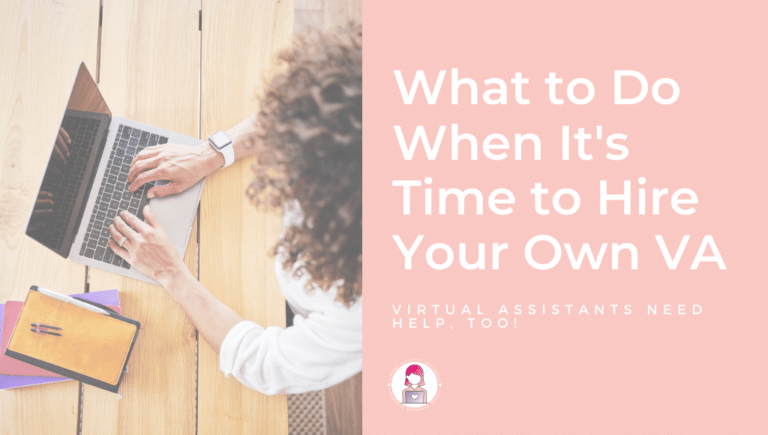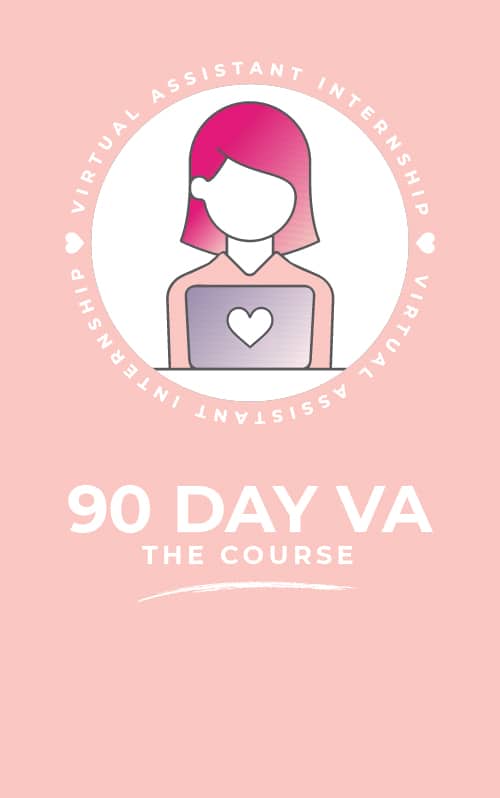You’ve reached the point in your virtual assistant journey where you’re overwhelmed, you’re turning away work, missing deadlines, wasting time on tasks you’d rather not be doing, wanting to focus more on growing your business, and so on.
I’ve been there! And do you know what that means?
It’s time to outsource, baby!
Outsourcing is completely normal as a virtual assistant, and quite honestly, this is a major sign of growth! Although it may seem a bit stressful, take a step back, and realize how far you’ve come.
The fact that you’re thinking of outsourcing to your own VA is huge!
The good news is if you’re reading this blog, you’re probably a VA yourself, so you’re already familiar with how to outsource work to someone else.
But knowing how to accept work as a VA versus outsourcing it to someone else can feel overwhelming, especially if it’s your first time.
So, here are my top 3 tips on how you can prepare yourself to outsource to another virtual assistant.

1. Know What You’re Going to Outsource
It’s crucial to have an idea of the kinds of tasks you want to outsource to someone else.
Can you imagine if you started working with a client and he or she had no idea what to send you?
You’d be sitting there like, “Um, hello? You’re paying me to do things, but I’m wondering if you forgot about me?”
The last thing you want your client to do is to give you 20 hours of work in one week when you agreed to 20 hours per month. All because they didn’t know how to delegate the tasks to you each week.
So, know WHAT you’re going to outsource before you actually outsource.
When in doubt, take note of how your clients delegate tasks to you and organize your work in a way that’s easy to pass on to someone else.
A good ol’ fashion braindump can also help do the trick. Write down every single task that you do and make a list of the ones that you enjoy, and the ones you don’t.

2. Create Processes and Set Up Communication Tools
Along with knowing what tasks you want to pass on, it’s essential to have your systems and processes in place. Not only does this make the transition easier, but it will be a lot less confusing when you onboard your new VA.
Think back to the clients you work with:
- How did they train you to do the job?
- How did they send you the files to edit?
- How do they communicate with you?
- What platforms do they use in their business to delegate tasks to you?
- What has worked?
- What hasn’t worked?
The following are all processes that you need to have set up and ready to go before you do anything else:
Video Training
Filming video tutorials are hands-down one of the best ways to train a new hire when you work remotely. Since many virtual assistants live in a different state or country than their client – this is the most efficient way to train someone.
It’s much easier for things to get lost in communication as a virtual worker, so filming a quick tutorial on how to do something will help answer any questions and clear up any confusion your VA may have.
If you’ve already been working as a virtual assistant, then you’re probably familiar with Loom.
If not, it’s an application you can download onto your computer that will record your camera, microphone, and desktop simultaneously as you explain what it is that you’re doing.
Video tutorials are also great to reference when your new hire forgets or can’t remember how to do the task. They can pull up the video, re-watch the tutorial – Wham! Bam! Boom! Done.
File Transfers
Like your clients transfer their files to you, be sure you have a similar process for your VA. If you’re sharing photos or video and podcast files, you need to have them in an accessible file somewhere for your VA to access.
Consider options like Google Drive or DropBox. Both storage options allow you to share, store and access any files or folders from any mobile device or computer.
You can also give your VA limited access to passwords and login information via LastPass. Once they download the extension onto their browser window, they can use it to log into any website needed to complete the work you’ve outsourced to them.

Task Management Systems
Using task management systems like Asana gives you an easy and convenient way to communicate or delegate tasks to your virtual assistant. You can assign due dates, recurring tasks, attach files and documents, start conversations, etc.
There are other options that are similar, free, and available to use. It’s entirely up to you and what you’re comfortable with, but pick a system and stick with it. As long as your VA can access what they need and communicate with you when needed, you’re good to go.
Communication Tools
While you can communicate in a project management system like Asana, I highly recommend using a tool called Slack. Think of it as instant messaging but for business.
You’ll no longer have to worry about messages getting lost in back-and-forth emails.
Save yourself time by creating a communication channel on Slack so that you’re VA’s have quick and instant access to you when needed.
You also want to make sure that you chat with your virtual assistant more often than not. If you haven’t heard from them in a while, send them a quick message and check in on them to see how they’re doing.
Schedule a Zoom call, share any updates, go over plans, and get to know each other. Zoom calls don’t have to be a regular thing, but your VA should understand that the option is there if they want to speak with you about anything specific.
Working with your VA should be no different than when you work with your clients.

3. Know What Qualities You’re Looking For in a VA
You have a list of all the tasks you want to outsource, and your systems and processes are all set. Now, it’s time to search for the right virtual assistant for the job.
Do you want a VA specializing in a particular niche or a general one to help with all the things?
Be clear on what kind of virtual assistant you are looking for because then you can hone in on a select few rather than the giant pool of VA’s that are out there.
Then, create a job description that you can share across online job boards, Facebook groups, Instagram stories, etc.
Facebook groups are a personal fave because there are so many networking opportunities! Join the ones that are relevant to you, your niche, and your client. You’re more likely to find someone with similar interests who would jump at the opportunity to work for you!
You can also create an Airtable form with specific questions for potential VA’s to fill out regarding your fancy new job description. It also makes it easy for you to sort through each application based on their answers or any portfolio pieces and attachments they provide because it’s all in one place.
Helloooo to ALL the time you now have because you didn’t waste it on scrolling through your email inbox trying to make sure you’ve read every application!
Don’t forget to ask your network for any recommendations too! Word-of-mouth is one of the best ways to find the exact person you are looking for!
Once you narrow down your options, do a trial period with the best candidates. It can be anywhere from 30-90 days if you want someone to help you long term. If it’s for a shorter period, a week or two trial will do!

Now, it’s your turn! You’ve been on the opposite end before, applying to job after job, trying to find the right client for you. So, you know what you need to bring to the table as a VA, but now YOU’RE THE ONE LOOKING TO HIRE.
It’s time to take what you’ve learned and put it to the test. Combine the knowledge you’ve experienced as a VA, how your clients work with you, and create a system that works for your business.
Focusing your time and energy on projects that fulfill you is so important, and outsourcing is a necessary step to avoid burnout.
The moment you outsource your work to someone else, the better you’ll feel and the less overwhelmed you’ll be.
Just remember to get all of your ducks in a row right from the start. Then, the onboarding process will be a breeze!
If you’ve made it this far and you’re NOT a VA, and you think you want to learn more, I’d like to invite you to check out my FREE masterclass. You will find everything that you possibly need to know to get started as a virtual assistant.




